
Microsoft Teams vs Zoom – Which Video Conferencing Service is Best for Your Business?
There are as many video conferencing tools as there are Microsoft versions, probably more. Some are free with limited features, some are expensive, some are useless. But there are very few that are constantly in the news and dominating the market – Zoom and Microsoft Teams. Both went through the roof over the last two years while every company on this planet was adapting to the new normal and mobilising their workforces to be able to stay connected, get some face time in and share updates as they would do in an office. Another great thing about both platforms are the filesharing and recording capabilities that target the collaboration aspect of a great office tool.
In this article, we are going to talk about Microsoft Teams vs Zoom – their features, licensing, advantages and disadvantages and will provide everything you need to know to find the perfect video conferencing tool for your business. Let’s get started!
Plans and pricing
First and foremost, both Microsoft Teams and Zoom have substantial free tiers. The primary distinction is that Teams includes video calls, 2GB of personal cloud storage, and unlimited chat, whereas Zoom is just available for video conferencing.
There are also differences between the two free versions in terms of call time limits. The Zoom meeting time limit has been temporarily increased to 40 minutes, while the Microsoft Teams limit has been temporarily increased to 24 hours (it’s unclear when the old 60-minute restriction will be reintroduced).
Microsoft Teams
We’ve written about different Microsoft packages here, with external links to the Business suite and Enterprise suite. However, Microsoft structure their pricing much easier than Zoom does. It is as simple as the following: Teams is always included as part of your subscription.
Microsoft 365 Business Basic offers the option to schedule and record Microsoft Teams meetings, as well as increased file storage capacity to 1TB per user and enhanced security features.
Meanwhile, Microsoft 365 Business Standard comes with all the bells and whistles of Basic and offers desktop versions of Microsoft’s productivity tools (Word, Excel, PowerPoint, and so on) as well as business apps like Bookings, Invoicing, and MileIQ on top of that.
Finally, Microsoft 365 Premium has enhanced security and privacy capabilities, as well as more device management choices.
That being said, we are focussing on Teams vs Zoom and not on the many other features that MS 365 comes with. It’s great to know that you will have access to it no matter what package.
Zoom
Zoom’s plans and pricing structure is definitely more complicated than the above. There are bundles, stand-alone products, combinations of both and so on. Don’t believe us? Just watch. We are going to focus on the United bundles as it’s their bestseller.
All versions come with the option to buy an unlimited calling plan for 18 different countries which serves really well for multinational businesses. But even if your company is UK-based only, you can benefit from unlimited calls to UK numbers. The first difference lays in the REST API limitation. Zoom categories them by account type and request type. The API can serve well for advanced users who want to extract information from Zoom directly into different programmes. This information could be anything from attendance names and questions, meeting reports and dashboard data. It gives your business the ability to track who spoke and for how long or how engaged participants were in a webinar.
The Pro version has limitations when it comes to manageability as it comes without an admin portal to review user count and billing information, no Single Sign-On and no user adding through domains. It’s fine for smaller organisations with a user count of less than 10 but it can become messy after a while, especially with high user churn. The Business and Enterprise plans have that included. We’ll focus more on features in the next section.
Features of Zoom and Teams
With Zoom Pro out of the way, it’s time to focus on the key differentiator between Business and Enterprise. As they cost the same, the biggest difference comes from how many users are working with the platform. Zoom draw the line at 100 users and back it up with a customer success team to look after your account. They keep an eye on adoption rate, ROI and keep you posted on the product roadmap. You become a bit more special once you hit the £2400 revenue mark.
In general and regarding video conferencing, Microsoft Teams and Zoom are very much alike. They both offer transcripts, blurred or other backgrounds, breakout rooms, recordings, text chats, Q&A’s, and so on. Users can also share one of their screens for a presentation to engage with users or simply to make sure that they don’t fall asleep. The recording features are quite neat when you’re looking at educational videos for your homepage or simply because you know that not everybody will be able to attend your session.
Microsoft Teams really shines when it comes to integrating with the rest of the Microsoft 365 portfolio of apps and services. Teams, for example, is tightly integrated with OneDrive and Sharepoint, making file sharing simple and intuitive. Meanwhile, a future PowerPoint integration will make taking notes during presentations and connecting with the audience easier.
However, Zoom’s App marketplace boasts hundreds of third-party connectors, significantly expanding the company’s capabilities. Some staff will like Zoom’s brighter, less cluttered UI, which is simple to use even for the least tech-savvy personnel.
Long story short: if you plan to use Zoom for video conferencing only and have a different chat tool in place, you’re definitely not missing out compared to Teams.
Security
The new normal is here whether you like it or not. This is not going to be another article about the horrors of switching from office to remote work. But if there was only one thing to consider about the tools that you have in place, it’s cybersecurity. There are a bunch of questions surrounding video conferencing and other collaboration tools. Who can join and from where? Is my stream accessible for uninvited, potentially bad actors? Where does my recording go? Where is my data hosted? One of those benchmarks is end-to-end encryption (E2EE). Communication between meeting participants is secured using cryptographic keys that are only stored on the devices of the users. This implies that no one else, including the service provider, has access to the decryption keys for private meeting data.
In the early stage of the pandemic, Zoom were standing right in the line of fire because their claims to provide E2EE was proved to be wrong. Following a public apology, the firm promised to devote the next three months completely to enhancing the platform’s security. Zoom communications are now encrypted by default with 256-bit TLS encryption, with users having the option to enable full E2EE. It’s not unbreakable, not encryption is but a single computer would need about 3*10^60 years (or in other words 3 trillion trillion trillion trillion trillion years) to decrypt the key. The universe is “only” 14 billion years old to put things into perspective. Unless the brute-force attack is very lucky (1 to 3*10^60 kind of lucky), your stream or conference is safe.
Teams are definitely falling short in this category as it only has E2EE in place for one to one calls with the caveat that both participating parties have that setting enabled.
Zoom made it harder to join random meetings through the mandatory use of passwords, waiting rooms and features to remove annoying participants much much easier than before. That was always an easy thing to do with Teams. It also allows meeting hosts to disable videos for a less disruptive meeting atmosphere.
GDPR and many other country-specific regulations define the geographic location of where data is hosted. Both, Zoom and Teams, accommodate this demand with the option to choose the data centre in which data in transit is hosted. This is not a win nor a loss for either. In general, Zoom’s biggest problem was that they claimed to operate with E2EE but they didn’t. As of today, they are fully compliant as far as encryption for data in transit goes – whether 2 people are on the call or 4000.
Onboarding and Support
Although Zoom and Microsoft are not in the same ballpark when it comes to company size or revenue, there is not much difference regarding customer success. The deployment and onboarding options are very similar and work equally well. Both tools have agents for the most common operating systems including Windows, Mac, Linux, Android and iOS. Both also come with a browser version for attendees to join which allows people without the tool installed to join your calls. This is especially practical for demos, catch up calls, team meetings and webinars.
Zoom is a bit more agile and flexible regarding their support with shorter SLAs, a support chat and lots of video content and tutorials. Their knowledge base is extensive and leaves no questions open. On top of that, it feels like they are closer to their community and work on suggestions from their own customer forum but also other platforms like Reddit. This shows commitment to their users.
Given Microsoft’s size and the recent switch of focus from direct to business towards a distribution heavy sales operation, it’s fair to say that the personal support suffered. What hasn’t fallen short are the very well looked after knowledgebase articles. Every tiny bit is documented and ready to be read from everywhere. Once the right support rep is on your case, you will also get a solid answer but it might take some time.
In summary, both Teams and Zoom will help you to get the best out of your video conferencing experience. They rely on happy, recurring customers and the competition is waiting for them to make a mistake. This is why they are going to continuously improve their services.
Conclusion
Zoom has exactly one mission: make video conferencing as easy as possible for everybody. Their whole company is built around high-performance video conferencing. The tool is simply better. Nonetheless, the services are very similar. As always, choosing one over the other comes down to your company’s needs.
If price is the main driver but you don’t want to miss out on video conferencing, Teams is definitely the right tool for you. If your goal is to provide higher-quality pictures and better sound, Zoom is an excellent alternative and the market leader for a reason. Their user interface is second to none, very intuitive and simple to navigate.
In terms of brand awareness, Zoom became one of those words that stand for the action carried out rather than the brand – a bit like Google. Most people who worked during the pandemic will have a clear idea of what Zoom is and how to use it.
Continue reading:
‘You Can’t Get There From Here’ – Then How Do I Get There?!? – IQ in IT
Co-Managed Technology – IQ in IT
Ransomware, Spyware and Trojans – What are They and How to Prevent Them – IQ in IT

















Recent Comments